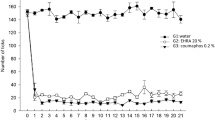Abstract
Beetles of the species Alphitobius diaperinus, Dermestes bicolor, and Dermestes lardarius may transmit severe agents of diseases on poultry and may in addition harm as larvae the skin and feathers thus leading to severe economic losses. The present study deals with a control measurement using a neem seed extract (MiteStop®) being diluted with tap water. It was shown that spraying of a 1:33 dilution kills both larvae and adults of these part-time parasites as was previously shown for other parasites such as mites, ticks, and blood sucking or biting insects.





Similar content being viewed by others
References
Abdel-Ghaffar F, Semmler M (2007) Efficiency of neem seed extract shampoo on head lice of naturally infected humans in Egypt. Parasitol Res 100:329–332
Abdel-Ghaffar F, Semmler M, Al-Rasheid KAS, Mehlhorn H (2009) In vitro efficacy of ByeMite® and Mite-Stop® on developmental stages of the red chicken mite Dermanyssus gallinae. Parasitol Res 105:469–471
Abdel-Ghaffar F, Semmler M, Al-Rasheid K, Klimpel S, Mehlhorn H (2010) Comparative in-vitro test on the efficacy and safety of 13 anti-head-lice products. Parasitol Res 106:423–249
Al-Quraishy S, Abdel-Ghaffar F, Al-Rasheid KAS, Mehlhorn J, Mehlhorn H (2011a) Observations on effects of a neem seed extract (MiteStop®) on biting lice (mallophages) and blood sucking insects parasiting horses. Parasitol Res. doi:10.1007/s00436-011-2495-0
Al-Quraishy S, Abdel-Ghaffar F, Al-Rasheid KAS, Mehlhorn J, Mehlhorn H (2011b) Effects of a neem seed extract (MiteStop®) on mallophages (featherlings) of chicken: in-vivo and in-vitro studies. Parasitol Res. doi:10.1007/s00436-011-2533-y
Eckert J, Friedhoff KT, Zahner H, Deplazes P (2008) Textbook of parasitology for veterinarians, 2nd edn. Enke, Stuttgart
Heimbucher J, Kutzer E (1978) Getreideschimmelkäfer (Alphitobius diaperinus) in Hühnerbetrieben. Vorkommen und Bekämpfung. Wiener Tierärztl Wschr 66:334–337
Heukelbach J, Oliveira FA, Speare RC (2006) A new shampoo based on neem (Azadirachta indica) is highly effective against head lice in vitro. Parasitol Res 99:353–356
Jacobs W, Renner M (1988) Biologie und Ökologie der Insekten. G. Fischer, Stuttgart
Klaschka F, Jung D (1976) Sensibilisation against Trogoderma angustum sol as job-derived disease (in German). Z Hautkrankheiten 51:177–183
Mehlhorn H (ed) (2008) Encyclopedia of Parasitology, vol. 1, 2, 3rd edn. New York, Springer
Pittermann W, Lehmacher W, Kietzmann M, Mehlhorn H (2008) Treatment against blood sucking insects without skin irritation. SÖW J 134:36–43
Rommel M (ed) (2000) Parasitosen des Geflügels. In: Rommel M, Eckert J, Kutzer E, Körting W, Schneider T (eds) Veterinärmedizinische Parasitologie, 5th edn. Parey, Berlin, pp. 421–422
Schmahl G, Al-Rasheid KAS, Abdel-Ghaffar F, Klimpel S, Mehlhorn H (2010) The efficacy of neem seed extracts (Tresan®, MiteStop®) on a broad spectrum of pests and parasites. Parasitol Res 107:261–269
Semmler M, Abdel-Ghaffar F, Al-Rasheid K, Klimpel S, Mehlhorn H (2010) Repellency against head lice (Pediculus humanus capitis). Parasitol Res 106:729–731
Sheldon JM, Johnston JH (1941) Hypersensitivity to beetles. J Allergy 12:493–494
Weidner H (1982) Bestimmung der Vorratsschädlinge und des Hausungeziefers Mitteleuropas, 4th edn. G. Fischer, Stuttgart
Wiesner E, Ribbeck R (eds) (1978) Wörterbuch der Veterinärmedizin. VEB G. Fischer, Jena (Vol. 1 A-K, Vol. 2 L-Z)
Wiseman RD, Woodin WG, Miller HC, Myers MA (1959) Insect allergy as a possible cause of inhalant sensitivity. J Allergy 30:191–197
Wittich FW (1940) Allergic rhinitis and asthma due to sensitation to the Mexican Bean weevil (Zabrotes subfasciatus). J Allergy 12:42–45
Acknowledgment
Hereby, we gratefully acknowledge the support by the Center of Excellence of the College of Science of the King Saud University at Riyadh, Saudi Arabia.
Author information
Authors and Affiliations
Corresponding author
Rights and permissions
About this article
Cite this article
Walldorf, V., Mehlhorn, H., Al-Quraishy, S. et al. Treatment with a neem seed extract (MiteStop®) of beetle larvae parasitizing the plumage of poultry. Parasitol Res 110, 623–627 (2012). https://doi.org/10.1007/s00436-011-2535-9
Received:
Accepted:
Published:
Issue Date:
DOI: https://doi.org/10.1007/s00436-011-2535-9




